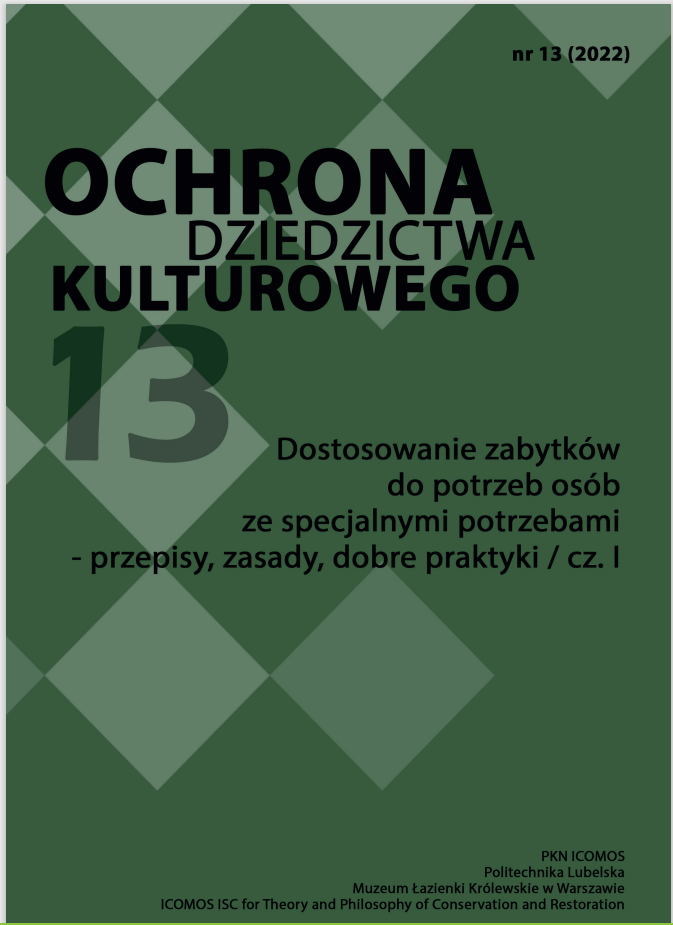Accessibility of Cultural Heritage
Article Sidebar
Open full text
Issue No. 13 (2022)
-
An Intricate Encounter? Cultural Significance and Accessibility in the Conservation of the Nineteenth- and Twentieth Century Monuments of Thessaloniki
Dimitrios Zygomalas7-24
-
Technological Artifices: Good Practices for Inclusive Communication in Museums
Gianluca D'Agostino, Cristina Boido25-36
-
Communicating a Conservation-Restoration Project: The Case of Chapel of Original Sin at the Sacro Monte di Varallo
Greta Acuto37-50
-
Accessibility of Cultural Heritage
Calogero Bellanca, Susana Mora Alonso-Muñoyerro, Cecilia Antonini Lanari51-68
-
Accessibility and Enhancement of Cultural Heritage: Examples of Best Practices in Europe
Rosa Anna Genovese69-84
-
Conservation Theory and the Accessibility of Monuments /on the Example of the High Castle in Malbork/
Grzegorz Bukal, Agnieszka Kowalska85-100
-
Authenticity and Interpretation for the Personal Appropriation of Heritage in Museums
Michela Benente, Valeria Minucciani101-110
-
The Role of Local Communities in the Discourse of Controversial Heritage of Norway and Estonia
Ave Paulus, Arnstein Bard Brekke111-128
-
Accessibility to the New Geoparq of Siurana
Josep Maria Adell-Argilés, Susana Mora Alonso-Muñoyerro, Dolores De La Piedra Gordo, Miguel García Jiménez, Edgar Lombana Echeverry129-142
-
From "Lodz Art" to "Friendly City". Good Practices or New Quality in the Dissemination of Cultural Assets?
Aneta Pawłowska, Daria Rutkowska-Siuda, Paulina Długosz143-158
Main Article Content
DOI
Authors
cecilia.antoninilanari@uniroma1.it
Abstract
Accessibility is a fundamental point to enjoy cultural heritage. An operative aspect which with different theoretical methodologies and practical projects can reach critical-conservative solutions. A first step may be to conserve the different stratification, all historic periods, and the impact in the surroundings for single preexistences and archeological sites. For archeological sites, it is necessary not to forget historical solutions which contributed to inspire the Venice Charter. A second step is an urban dimension for the accessibility in the historic centres and the pedestrian itineraries. To summarize the values Riegl, as we know, divided them in two main groups: the memorial values as age value, historical value and intended memorial value; and the present day values as use value, art value, newness value and relative art value. And when there is a conflict between use value and historical value, the treatment of a monument should, above all, take into account the age value. This will be a principal for the guidelines in the problem of accessibility. Many of these problems can be resolve with an appropriate design. This reintegration of the image even for the urban restoration than for the conservation of environment. In this paper, we want to present different ways of making the cultural heritage accessible to everyone, not only the obvious priorities of physical accessibility, but also accessibility in the form of understanding and experiencing.
Keywords:
References
ICOFOM, ICOM -CC, 25° General Conference, Kyoto 2019, “What is the essence of conservation”, edited by Francois Mairesse and Renata F. Peters
Bortolotto Ch., (2007), “From the monumental to the living heritage: a shift in prospective”, edited by White an Carman
Bortolotto Ch., “World heritage: global challeges local solutions”, Oxford, Archeopress
Pane Andrea, (2005), “Accessibilita e superamento delle barriere architettoniche negli edifici e nei siti storici: alcuni problemi ricorrenti”, Arkos, no. 11
ARKOS, “Percorsi multisensoriali per non vedenti”, ErfoniX ART
Vitagliamo Giuseppe, (2004), “Conservazione e accessibilita: il superamento delle barriere architettoniche negli edifici e nei siti storici” edited by Renata Picone, Napoli, Arte tipografica,
AA.VV., “Recupero e conservazione”, no. 89
Atti de122° Convegno di Bressanone 2006
Atti de129° Convegno di Bressanone 2013
Bartolomucci Carla e Giannattasio Caterina, “Il conflitto tra accessibilita efruizione nel progetto di conservazione”, in Recupero e conservazione, 2010
Pane Andrea, (2013), “Entrance to Pompeii: accessibility, fruition and conservation of the area of Porta Marina” in Atti del 29° Convegno di Bressanone
Picone Renata, (2013), “Accessible Pompeii. A research for the broader use and enhancement of the archaelogical site” in Attide129° Convegno di Bressanone
AA.VV., (2005), “Urban pasts and urban futures: bringing urban archaeology to life. Enhancing urban archaeological remains”, Committee of the Regions, Brussels,
Pane Andrea, (2005), “Accessibilita e superamento delle barriere architettoniche negli edifici e nei siti storici: alcuni problemi ricorrenti”, ARKOS, aprile/giugno
Charlton Neal, Helmsley Castel (2003) in “Building consertion jornal” RICS 33,
Ribera Federico e Cucco Pasquale, (2020), “Kenzo Ttange and the space of communication: the never achieved project fot the accessibility of the old town of Spoleto in Italy”, Journal of
Architectural conservation, no. 1, vol. 26
Agostiano Maria, (2013), “The accessibility of archeological sites”, in Guidelines to overcome architectural barriers in cultural heritage sites, Italian Ministry of Cultural Heritage,
Cultural Activities and Tourism, in Atti del Convegno di Bressanonne
Article Details
Abstract views: 332
License

This work is licensed under a Creative Commons Attribution-ShareAlike 4.0 International License.






